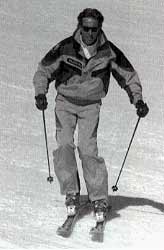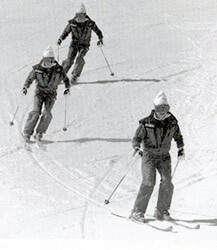Pre-season Fitness Tips
Fall Preparations
Getting Ready For The Snow
Dealing With Altitude
Hiking For Fitness
Stay Active
![]()

![]()

Pre-season Fitness TipsPhysically: |
Exercise 3: Get in the same position as 2. Grab your desk with both hands at about the same position as the skier above. Now press
down your feet while pushing up against your desk. Now we have your upper body involved. The movements and muscle used while performing these exercises are the same as
when I’m skiing. |
Fall PreparationsWell, Ski Clubbers, fall is here and we should be trying to get in better shape for skiing.Great ways to strengthen the body are by jogging, cycling, swimming, power walking or going to the health clubs. While the weather is still suitable, you can cycle, jog, or walk along the Rock Island Trail. It’s a great place to work out. Start out slow and increase the pace as you develop. If you want additional challenge try out Jubilee Park. The paved roads with their hills will provide you with a good workout and the scenery is great also. Want more of a challenge, try the trails in the woods for a great workout. There are big hills and hollows. When the weather gets colder, go to the Northwoods Mall and do your power walking or exercise at the various health clubs in town. Also, don’t overlook using the stairs in your home. This is not only low impact on the legs, but because of the lifting and pushing is a great exercise for skiing. |
Consider going on the 1 and 2 day trips to help you prepare for the big western trip you have planned. Now that you are getting in shape, it’s also important to check out your equipment. Does anything need to be repaired or replaced? Do the skis need tuning, sharpening, or waxing? Now is a good time to get these things done, not the evening before you leave on your trip. If we prepare ourselves and our equipment early, before the season ahead, we should have a more enjoyable trip and certainly enjoy more runs on the slope. See ya’ on the mountain. |
Getting Ready For The SnowHey, Ski Clubbers you need to think about getting ready physically for next ski season. Now if you are already a bicyclist, runner or belong to a health club, you don’t need to read this. This is for the average weekend jock or jockett! We walk for our health. Walking is good for your heart, low back, knees, hips and builds stamina; all things you need for skiing. This is an especially good exercise for women. A 40-minute walk only 3 times a week will lower incidence of osteoporosis later in life. Of course, you still need proper diet and supplements. We think walking every day is great, but 3 times per week is a good goal to start. Walking is also a good stress reliever.Try it! You will be glad you did when the coming ski season arrives. Stay Healthy! |
Dealing With AltitudeMidwest Ski Trips have lower altitudes and do not produce problems with breathing and/or hydration. As we head West, there will be various changes. The air will become much thinner due to the higher altitude and combined with the cool air, ice, and snow, will also become much drier.At Aspen/Snowmass, we will be staying at about 8,200’ and skiing upward of 11,835’ on Big Burn. With the dryness of the air, as we exhale, we expel a lot of moisture. Also, due to the thin air, we push ourselves harder which increases our breathing rate, which in turn causes additional loss of body moisture. We need to replace lost body moisture by drinking plenty of water or a hydrating substitute like one of the sports-oriented beverages. Refrain from drinking coffee, sodas, and alcoholic beverages, which while enjoyable, will actually increase your body’s fluid loss. Save these for after skiing, but don’t overdue the alcohol as it makes the adjustment to the altitude more difficult. Replace the moisture you need by wearing a Hydration Pack, not to large though, or carry a small bottle of water in an inside pocket where it won’t freeze. Replacing the moisture you lose will help keep your body stronger and healthier regardless of where you ski. |
Some people experience altitude sickness at the higher elevations for a couple of days. If you drive or take the train, it sometimes helps as your body begins to adjust as you travel. Also stopping overnight, such as in Denver, will help the adjustment. If you have experienced altitude sickness in the past, you may wish to check with your Doctor, as I believe they can prescribe medication which can be taken ahead of time. Another very important item to be aware of is the increased risk of sunburn. This is due to the air being thinner and much clearer. Don’t take a chance with the sun. Take your sunscreen lotions and use them, even on partly cloudy days. Generally recommended are sun screens with a minimum of SPF 15, however, a higher rating is certainly acceptable. With proper equipment and preparation you will have enjoyable times on the slopes. So have a great trip. |
Hiking For FitnessIt seems too early to think about ski conditioning, but what if the perfect training spots were close to home and outdoors on some of the Midwest’s most beautiful wooded hillsides? Well, Peoria has two local treasures: Forest Park Nature Center and Detweiller Park. Both offer the perfect place to get into shape for the ski season.Hiking their steep wooded trails provides an excellent way to build what I think is the most important aspects of ski conditioning: Strength, endurance, and visual perceptivity. First, hiking hills at a fast pace, up and down, builds strength both in the quads, gluts and hamstrings---vital muscles to skiing with confidence. Without prior conditioning you’ll end up yelping in pain the first few mornings of a ski trip. I know that feeling well, even from my “salad days” back in the seventies when few of us worried about pre-ski physical conditioning, circuit training, Nautilus equipment, etc., as many of us do now. Anyway, back to the big advantages of hiking: As you walk, slowly at first, then more quickly up and down the trails at Forest Part or Detweiller with your head up, your back straight, and your arms cocked at a ninety degree, your heart will almost immediately start pumping like crazy. Great! Your blood is flowing vigorously. This is a good thing, but don’t forget to breath slowly and deeply, in through the nose and out through the mouth. |
As you climb over roots, rocks and uneven terrain, your heart as well as your quads and hamstrings are working hard. If you keep your stomach muscles tight, and try to squeeze your gluts with every other step, you’re working the abs too. But you’re also working on another vital component of alpine skiing: visual perceptivity. This sounds like teacher-talk, but it simply means that the unevenness of the trail requires you to negotiate rocks, roots, eroded areas, muddy spots, gravelly spots, etc. You’re making constant decisions based on distant as well as near objects. This is similar to skiing where you’re always looking ahead to choose your best route, maybe through a bump field or lumpy snow (mashed potatoes we used to call it remember that?) Often you need to avoid steep drops, icy spots, ruts or other skiers, but it all falls under the very important component of confident and safe skiing and that’s called “reading the terrain.” Hiking the trails at Forest Park or Detweiller (or anywhere else of course) will help with all three components of fitness: Strength, endurance and visual perceptivity, but there’s one more advantage to this kind of training and that’s balance. It’s the primary physical skill needed for so many sports, skiing especially, and navigating uneven up and down terrain, climbing over roots and ruts, crossing ravines and creeks will help build balance as well as strength, endurance and visual perceptivity, so hit the local slopes before the snow flies. Bon courage! |
Stay ActiveYou will have more fun skiing if you are in good physical condition. The first day of a ski trip is not the time to start an exercise program. Stay active this summer; bicycling, walking, swimming are all good ways to increase strength and flexibility. Attend my bike rides. They are easy rides to enjoy with your friends that I hope will encourage you to ride 3 to 4 times a week to build your legs for skiing this winter. |